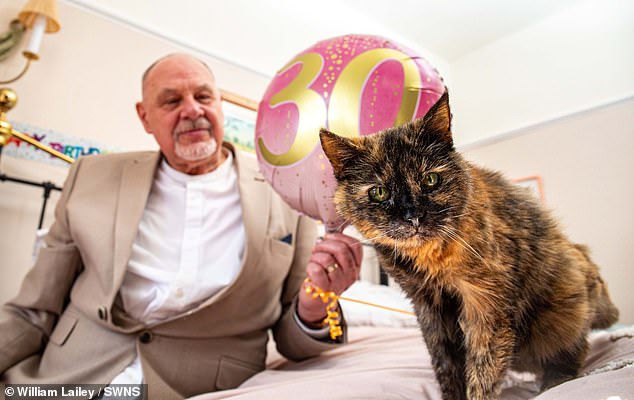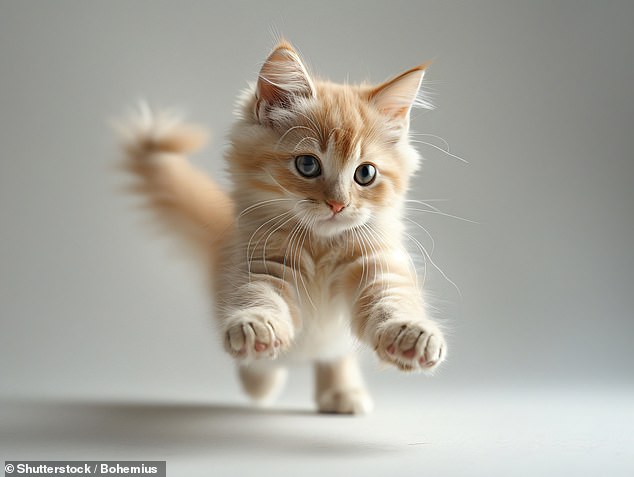A tortoiseshell cat named Millie hit the headlines this week after celebrating her 30th birthday – making her the oldest feline in the world.
According to popular legend, one human year is the equivalent of seven ‘cat years’.
If this was true, that would make Millie the equivalent of a 210-year-old woman!
However, in reality, it’s slightly more complicated than this.
‘Differing with each age, cats have a shorter lifespan than we do and so their years are equivalent to many human years,’ Purina explained.
‘If we want to compare, we can work out cat years to human years with simple maths.’
To help you work your kitty’s ‘true age’, Purina has developed a simple Cat Years Calculator.
So, is your cat still a cheeky youngster or is it wise beyond its years? Take the test to find out.

A tortoiseshell cat named Millie hit the headlines this week after celebrating her 30th birthday – making her the oldest feline in the world
How old is your cat in human years?
According to Purina, the first year of your cat’s life is actually considered the equivalent of 15 human years.
The second year then adds nine more human years – so two cat years are approximately 24 human years.
After this, each additional human year is four ‘cat years’.
So, by age three, your cat will be 28 human years, while by their sixth birthday, they’ll be the equivalent of a 40-year-old human.
‘Cats age very quickly in their first two years of life, after which the process slows down and becomes more gradual,’ Purina explained.
‘The way in which a cat’s age is determined is based off its physical and behavioural changes.
‘These stages are then matched to those of a human life cycle.’
How to estimate how old your cat is if you haven’t had them since they were a kitten
If you haven’t had your cat since they were a kitten, there are five tell-tale signs that should give you a good idea of their age – teeth, fur, eyes, muscles and bones.
Teeth
‘Teeth can’t pinpoint the exact date for your feline friend’s birthday party, but they are still a great indicator of a cat’s age,’ Purina explained.
A kitten’s first teeth usually appear between two to four weeks, while their permanent teeth come in at around four months.
If you spot a few yellow stains, this suggests your cat is around one to two years old.
But if the stains appear on all their teeth, they’re probably at least three to five years old.
Meanwhile, if your cat is missing any teeth, they’re probably a ‘respectable senior’, aged between 10 to 15 years old.

A kitten’s first teeth usually appear between two to four weeks, while their permanent teeth come in at around four months
‘Keep in mind that some cats can just have worse teeth than others regardless of their age. This could be due to breed, upbringing, diet or health,’ Purina added.
Eyes
The colour of your cat’s eyes can also give you an indication of their age.
Young cats tend to have smooth irises (the coloured part of the eye), but these begin to crackle with age.
And after 12 years, cats’ eyes usually start to show some cloudiness, as well as regular tearing and eye discharge.
‘Your vet can look at [your cat’s eyes] closely with an ophthalmoscope (if your cat will let them!),’ Purina said.
Muscles and bones
Young cats tend to play more than older cats, giving them better muscle definition.
‘So, if you notice that your cat tends to lose muscle mass or they don’t like to move around too much, this might be a sign of ageing,’ Purina said.
In contrast, older cats tend to be bonier, have extra skin, or protruding shoulder blades.
Fur
Finally, your cat’s coat can give you a good indication of its age.
‘Fine, soft fur is usually reserved for young cats,’ Purina said.
‘Older cats often have a thicker, coarser fur, sometimes with patches of grey hair.’
Why is it important to know your cat’s age?
According to the experts, it’s important to understand your cat’s age so that you can prepare yourself for any age-related health issues that may occur.
‘Comparing this to human years helps us to do that better,’ Purina said.
‘Knowing when your cat has transitioned into their mature, senior cat years will help you give them the best care possible.’








